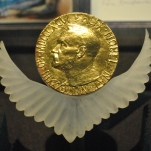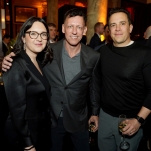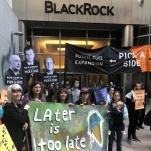Inspired by Ferguson, a young British artist returns to the slave triangle
At center stage of this Leeds, England theater is an empty glass box. When performance artist Selina Thompson finally appears, she’s wearing a giant white dress, dragging rocks of salt underneath her skirt. “It’s knackering,” she says. “But I want to show how exhausting carrying history can be. That’s why I’m taking these great big rocks and, by the end of the show, turning them to grains.”
Before a hesitant audience stands a black woman with a small crown of an afro, ready to tell the raw, gut-wrenching truth about slavery and colonialism. In February, Thompson went on a cargo ship to retrace one of the routes of the Transatlantic slave triangle, from the UK to Ghana to Jamaica. Her 90-minute show, “salt,” which premiered at Bristol’s Mayfest, is what she brought back.
Speaking about a month after she returned to Britain, Thompson remembers the physical exhaustion she felt at sea. “Being at sea is hardcore,” Thompson told me. “When I came back, my back was fucked, my shoulders as well. I had to keep having these deep-tissue massages, the kind of thing to loosen my body up.” She also injured her knee. “For me a huge part of my practice as a performance artist is endurance and is about putting myself through something and then standing on stage before you, presenting it back to you.”
It’s easy to say “salt” is just about the violence inflicted upon black people, but as the audience is plunged to the bottom of the Atlantic Ocean, they’re forced to see the reality of how the past collides with the present. Decades ago, Thompson’s Montserrat-born grandmother took a boat from the West Indies to Britain, not to create a piece of art, but in a wave of immigration. She died on the same date Thompson embarked.
“Doing the journey felt like a pilgrimage, and a time of reflection and meditation,” Thompson says. “We get so little time to grieve, to actually sit and come to terms with the fact that colonialism changed the world. That slavery changed the world in such violent, horrific ways. And that it lives in our bodies, and lives in our lives.” At the heart of Thompson’s work is deep honesty about her experience as a black British woman; her previous shows tackled black women’s relationships with their hair and questions about race.
-

-

-

-

-

-

-

-

-

-

-

-

-

-

-

-

-

-

-

-

-

-

-

-

-

-

-

-

-

-

-

-

-

-

-

-

-

-

-

-

-

-

-

-

-

-

-

-

-

-

-

-

-

-

-

-

-

-

-

-

-

-

-

-

-

-

-

-

-

-

-

-

-

-

-

-

-

-

-

-

-

-

-

-

-

-

-

-

-

-

-

-

-

-

-

-

-

-

-

-

-

-

-

-

-

-

-

-












































































































